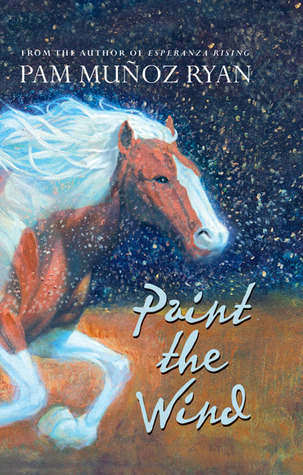
While checking my county library catalog for Pam Muñoz Ryan’s Echo, the description of Paint the Wind caught my eye because the story takes place in Wyoming. I’m always a little skeptical about stories supposed to take place in Wyoming, but I remembered, from years ago, that Ryan’s Esperanza Rising was surprisingly good. Echo, which I read recently, is very good. With nothing much demanding my time on the afternoon of New Year’s Eve, I picked up Paint the Wind and read the entire book before midnight.
The story opens with Artemisia, a wild mare, looking for a place to deliver her foal. The first several chapters then alternate between Artemisia and the main character, a girl named Maya. I was preparing for the back-and-forth to become tedious but, once both settings are established, it becomes more natural.
Maya has lived with her 88-year-old grandmother for the past six years, since her parents were killed in an accident when she was five years old. Maya goes to school, but otherwise, she is rarely allowed to leave the house. Her grandmother practically holds her prisoner in an effort to keep her safe and to make sure Maya’s education isn’t compromised by anything frivolous like toys, friends, or activities.
Maya has gone to eight different schools in her short life because Grandmother makes her change schools any time it seems anything frivolous goes on. There have been eighteen different housekeepers in the past six years. Since each housekeeper wants to keep her job, she becomes Grandmother’s ally in keeping tabs on Maya. So Maya has learned to lie. When Grandmother asks her about her day at school, she makes up stories. If Maya doesn’t like the latest housekeeper, she contrives pitfalls for her so she will get fired.
One morning at breakfast, Grandmother has a stroke and dies. Within twenty-four hours, Maya is off to Wyoming to live with her mother’s family whom she hasn’t been allowed to see since she was four years old. Grandmother had lied to Maya’s mother’s family about the terms of her parents’ will and to Maya about that side of her family, in order to keep them apart. She blamed Maya’s mother for the death of her son. She raised Maya to believe that her mother’s family were “actually hillbillies with no education and they live like pigs in an uncivilized land . . . and they don’t appreciate culture and are extremely crass and unsavory.”
Maya’s grandfather, his brother, Uncle Fig, and his sister Vi live on a ranch during the school year, and Vi teaches art history at the local college. During the summer, Vi sets up a field camp where she lives in a teepee, writes articles for magazines about horses, and takes photographers out to view the wild horses.
It just so happens that Maya arrives in early June. School is out, so her cousin Payton, who is nearly the same age as Maya, and who has been coming to the camp every summer, is already there. He doesn’t appreciate having this girl horning in on his time with Aunt Vi and the horses. Grandpa and Uncle Fig still have work in town, so they aren’t living in camp yet. Maya needs intense riding lessons, and she and Payton need to learn to get along. Aunt Vi literally makes them work it out.
Years ago, the mare, Artemisia, had been caught in a wild horse “gather” and Aunt Vi bought her in an auction. Maya’s mother had loved the horse, and the two had been inseparable. However, the mare had been stolen back by the stallion whose harem band she had belonged to, and she has been living in the wild for several years.
One day, Aunt Vi, Payton, and Maya witness a gather in which most of the wild horses in the valley are caught. However, they realize that Artemisia and her foal did not end up with the rest of the horses. From then on, they search for the mare and foal every chance they get, knowing that the horses are alone and have no protection from predators.
A day comes when Aunti Vi suddenly has to take off to town with Payton, and she leaves Maya alone with strict instructions not to leave the camp. A savvy reader knows immediately that Maya will leave the camp. And that is the rest of the story. There is danger, a catastrophe, wilderness survival, injury, rescue, and finding family.
Bravo, Pam Muñoz Ryan! Every time I thought the plot was going to turn trite and sentimental, it didn’t. I was prepared to find her portrayal of life in Wyoming, at the very least, inaccurate. It wasn’t. When she brought in the wild horse element, I thought, Oh, here we go, politics and environmental sentimentality. That wasn’t included. The wild horse question is presented as though there are two sides to the story, which there are. The three horse lovers regret the gather, but the story doesn’t turn political.
It is evident from the author’s long thank-you list that she devoted an extensive amount of time and effort learning to ride horses and also to learning about the West. I appreciate that!
There is one caution for sensitive readers. See below. *
This book is available at Amazon.
*Maya finds the remains of a foal that has been partially eaten by a mountain lion.
“[The] young body lay mangled and bloodied. Leaves and dirt half covered the sweet face in the cat’s frugal attempt to hide the kill. The smell of the desecration fouled the air. Maya’s stomach recoiled. She leaned against a tree, doubled over, and vomited. When she righted herself, tears stung her eyes.”